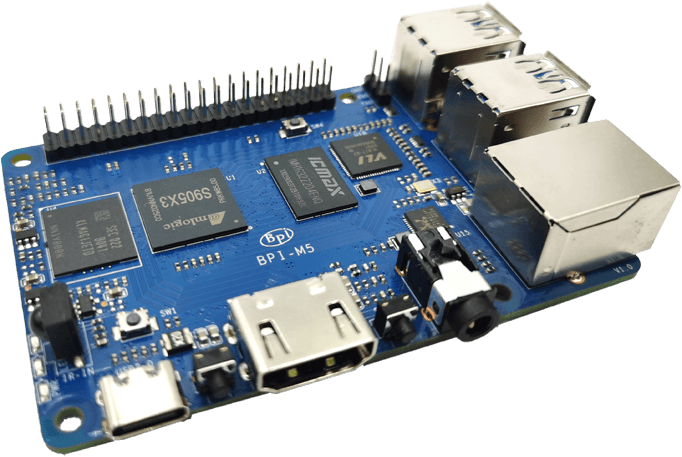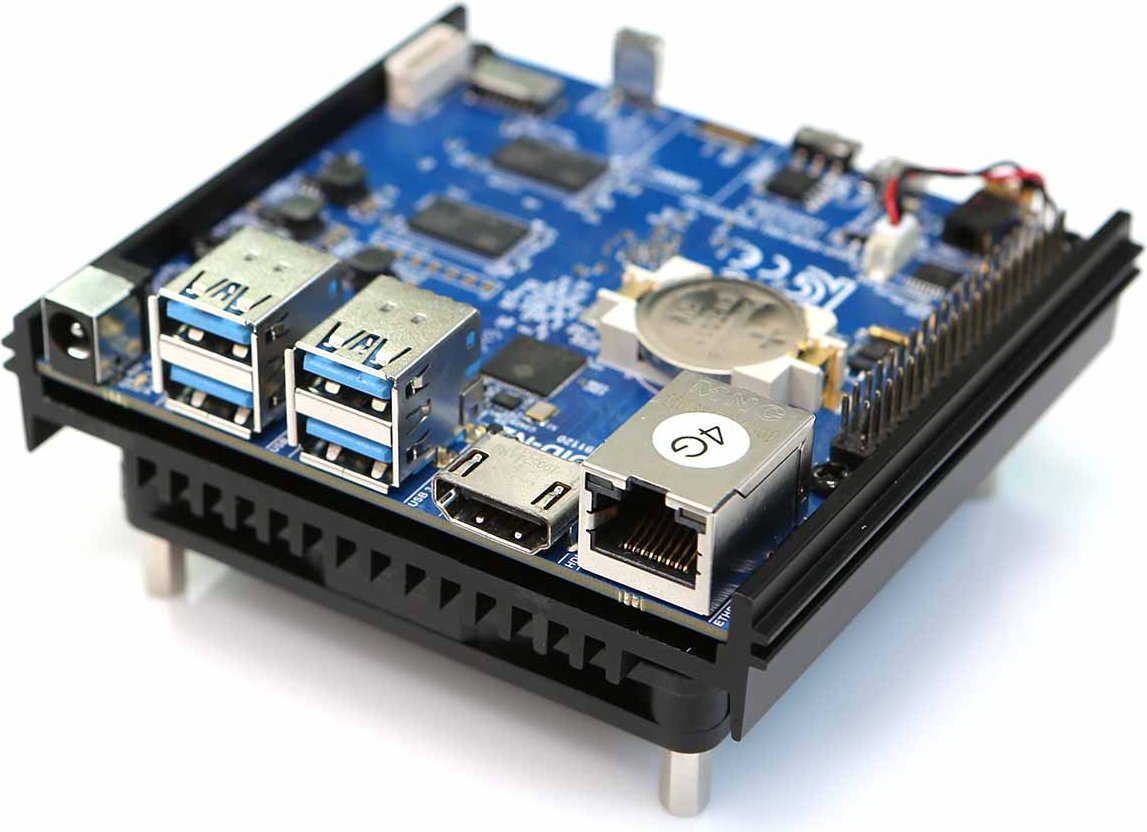 Image: Raspberry Pi Foundation
Image: Raspberry Pi Foundation
With more than 45 million units sold, the Raspberry Pi is not only by far the most successful single-board computer, but also the best-selling British computer ever. The single-board computer (SBC) has also won countless awards.
So it’s no wonder that the tiny development board from the British Raspberry Pi Foundation has spawned numerous imitators over the past 10 years. But which single-board computers are a viable alternative to the original?
We have taken a closer look at the current competitors to provide the answers. Here are four recommended alternatives to the Raspberry Pi 4 and Raspberry Pi 5.
Orange Pi 4 and 5
The Orange Pi 4 is a single-board computer from the Orange Pi series, which was developed by the Chinese company Shenzhen Xunlong Software Co, Ltd. This compact mini PC was built to provide developers and hobbyists in particular with a powerful and affordable platform for various applications.

Shenzhen Xunlong Software Co., Ltd.
Shenzhen Xunlong Software Co., Ltd.
Shenzhen Xunlong Software Co., Ltd.
Hardware specifications: The Orange Pi 4 has impressive hardware specifications that make it suitable for a wide range of applications. Key features include:
Processor (SoC): The Orange Pi 4 is powered by a powerful Rockchip RK3399 SoC (System-on-a-Chip), which consists of a dual-core Cortex-A72 processor and a quad-core Cortex-A53 processor. This combination offers sufficient computing power for demanding tasks.Graphics (GPU): The RK3399 chipset is equipped with a Mali-T860 MP4 GPU, which provides hardware acceleration for graphics applications. This also makes the Orange Pi 4 suitable for multimedia applications and games.Memory: The device has 4GB of LPDDR4 RAM, which is sufficient to run multiple applications simultaneously. It also has a microSD card slot for memory expansion.Connectivity: The Orange Pi 4 is equipped with Gigabit Ethernet, dual-band Wi-Fi (2.4GHz and 5GHz), Bluetooth 5.0, and multiple USB ports, which greatly expands connectivity options.Video output: It supports 4K video playback via HDMI 2.0 and also offers a DisplayPort output.Expandability: The device has GPIO pins and additional connectors that allow external hardware components and expansion boards to be connected.
Operating system support: The Orange Pi 4 is supported by various operating systems, including Android, Linux (with various distributions such as Ubuntu, Debian, etc.) and other community-developed operating systems.
Applications: The Orange Pi 4 is suitable for a wide range of applications including:
IoT projectsServer applicationsMultimedia streamingImage and video editingDevelopment platform for software developersControl of robots and other embedded systems
The latest evolutionary stage, the Orange Pi 5, now also offers an octa-core Rockchip RK3588S processor and up to 16GB LPDDR4X, making it suitable for particularly demanding tasks and ambitious projects.
Conclusion: The Orange Pi 4 is a powerful single-board computer with high-performance hardware specifications that is ideal for developers, hobbyists, and DIY enthusiasts. With its versatility and various connectivity options, it provides a solid foundation for a wide range of projects and applications.
The Orange Pi 5, on the other hand, is primarily aimed at professionals and users who want to realize particularly large projects with a high demand for computing power.
Users who opt for an Orange Pi 4 should bear in mind that the single-board computer usually has to be imported from China or the USA and is generally only available on Amazon.com. The Orange Pi 5 is currently also available from Amazon.
Banana Pi BPI-M4 and M5
The Banana Pi BPI-M4 is a member of the Banana Pi family of single-board computers developed by SinoVoip. These computers are characterized by powerful hardware and a cost-effective platform that is attractive to developers, hobbyists, and small businesses alike. The specifications are very similar to those of the Orange Pi 4.

SinoVoip
SinoVoip
SinoVoip
Hardware specifications: The Banana Pi BPI-M4 offers comparatively powerful hardware that supports a wide range of applications:
Processor (SoC): The Banana Pi M4 is powered by a powerful Allwinner H618 SoC, which consists of a quad-core Cortex-A53 processor and a quad-core Cortex-A53 processor. This combination offers plenty of computing power for demanding tasks.Graphics (GPU): With the H618 chipset and a ARM Mali G31 GPU, the device offers hardware acceleration for graphics applications and is therefore ideal for multimedia and gaming.Memory: The M4 offers just 2GB LPDDR4 RAM, compared to the Raspberry Pi 4’s 4GB. Storage expands via a MicroSD card slot.Connectivity: This single-board computer is equipped with Gigabit Ethernet, dual-band Wi-Fi (2.4GHz and 5GHz), and Bluetooth 5.0, offering a wide range of connectivity options.Video output: The Banana Pi M4 supports 4K video playback via HDMI 2.0.Expandability: The device offers GPIO pins and a GPIO header that enable the connection of external hardware components and expansion boards.
Operating system support: The Banana Pi M4 is supported by various operating systems, including Android, various Linux distributions such as Ubuntu and Debian, as well as other operating systems developed by the community.
Applications: The Banana Pi M4 is versatile and has applications in areas such as:
Multimedia streaming and playback: Thanks to its powerful hardware, the Banana Pi M4 can process multimedia content in high quality.IoT projects: With its connectivity options and GPIO pins, it is ideal for developing IoT devices and applications.Server applications: The Banana Pi M4 can be used as a server for web services, file sharing, and for other applications.Development platform: Software developers will find a platform in the Banana Pi M4 to develop and test applications and prototypes.Image and video editing: Thanks to its graphics performance, it’s also suitable for image and video editing tasks.
Conclusion: The Banana Pi BPI-M4 is a powerful single-board computer with high-performance hardware that supports a wide range of applications. It’s suitable for developers and hobbyists as well as small businesses looking for a cost-effective and versatile platform.
The Banana Pi M5 offers an alternative SoC, the Amlogic S905X3, along with 4GB of LPDDR4 RAM and is also available at a comparatively low price:
Compared to the Raspberry Pi 5 or the latest Orange Pi 5, the Banana Pi M5 is not quite as powerful, but is usually perfectly adequate for smaller projects and can score points with a competitive price. However, other alternatives are much more suitable for demanding applications.
Nvidia Jetson Nano
The Nvidia Jetson Nano is aimed in particular at users and developers who attach importance to high GPU performance, as the single-board computer has a very powerful integrated graphics unit based on Nvidia’s Maxwell architecture.

Nvidia
Nvidia
Nvidia
Hardware specifications: The Nvidia Jetson Nano offers extremely powerful hardware that supports a wide range of applications and focuses on GPU performance, AI, robotics, and automation:
Processor (SoC): The manufacturer lays the foundation for the Nvidia Jetson Nano with its in-house Nvidia Tegra, which can draw on four ARM Cortex-A57 with a clock frequency of 1.43GHz.Graphics (GPU): This is where the Nvidia Jetson Nano differs significantly from its competitors, as it uses a particularly powerful Maxwell GPU with 128 activated CUDA cores.Memory: The Nvidia Jetson Nano has access to a total of 4GB LPDDR4, which is connected to the CPU at 25.6GB/s and ensures fast operation.Artificial intelligence and deep learning: The Jetson Nano is particularly suitable for deep learning tasks. It supports common deep learning frameworks such as TensorFlow and PyTorch and offers fast inference speeds for neural networks.Versatile interfaces: The Nvidia Jetson Nano has a wide range of interfaces, including USB ports, HDMI output, Gigabit Ethernet, GPIO pins, and camera interfaces, making it an excellent choice for applications that require sensors and cameras.Developer-friendly: Nvidia offers extensive developer support, including a software development kit (SDK) and an active community. This facilitates the development and debugging of applications.Operating system support: The Nvidia Jetson Nano can be operated with various operating systems such as Ubuntu-based Linux distributions, which facilitates customization and integration into existing projects.
The Nvidia Jetson Nano has a wider range of applications than most other single-board computers and also offers more powerful developer tools with manufacturer support.
Of course, this comes at a price and so the single-board computer is in the highest price bracket in this segment at $150.
Conclusion: The Nvidia Jetson Nano is currently a good choice for users who are primarily planning projects in the fields of AI, robotics, automotive, and automation. However, if you only want to create a retro games console or a small media center, you should opt for a cheaper solution.
ODROID N2+
The ODROID N2+ from South Korean manufacturer Hardkernel is aimed at a wide range of applications. In addition to network storage solutions, multimedia centers, and retro games consoles, this single-board computer can also be used to implement professional projects.

Hardkernel
Hardkernel
Hardkernel
The technical specifications, features, and performance characteristics of the Hardkernel ODROID N2+ are as follows:
Powerful processor (SoC): The ODROID N2+ is powered by an Amlogic S922X SoC (System-on-a-Chip), which combines four Cortex-A73 CPU cores and two Cortex-A53 CPU cores to form a hexa-core SoC. The processor offers high computing power and is also capable of handling demanding tasks.Graphics performance (GPU): In addition to the processor, the ODROID N2+ has a powerful Mali-G52 GPU that supports high-resolution graphics and video playback in 4K resolution.Storage options: This single-board computer offers support for DDR4 RAM, providing ample memory for compute-intensive tasks. It also supports eMMC memory modules and offers multiple USB ports for external data storage.Expansion options: The ODROID N2+ offers a variety of ports, including USB 3.0 and USB 2.0 ports, Gigabit Ethernet, HDMI outputs, and GPIO pins. This makes it extremely versatile and enables the connection of a wide range of peripheral devices.Operating system support: The ODROID N2+ is compatible with various operating systems, including Linux distributions such as Ubuntu and various Android versions. This facilitates customization and integration into various projects.Media playback: Thanks to its powerful hardware, the ODROID N2+ is able to run 4K video playback, H.265 and VP9 codecs, and other multimedia tasks smoothly. This makes it ideal for media centers and consumer electronics.Energy efficiency: Despite its high computing power, the ODROID N2+ is energy efficient and can be used in environments with limited power consumption.Active community: Hardkernel has an engaged user and developer community that provides support and resources for application development and customization.Applications: The ODROID N2+ is ideal for applications such as media centers, home automation systems (“Smart Home”), network storage solutions, retro gaming consoles, and other demanding embedded (“Embedded”) and consumer electronics tasks.Robust construction: The ODROID N2+ is characterized by high-quality workmanship and a solid construction that ensures reliable performance over the long term.
The ODROID N2+ is a powerful single-board computer and is ideal for a wide range of demanding embedded and consumer electronics applications. With its powerful hardware components and versatility, it offers developers and engineers a powerful platform for projects that require high computing power. The single-board computer also scores with a comparatively favorable entry-level price.
Conclusion: The Hardkernel ODROID N2+ is a real all-rounder and is suitable for almost any type of project. The single-board computer is particularly suitable for streaming clients, media centers and network storage solutions, so-called Network Attached Storage (“NAS”).
This article was translated from German to English and originally appeared on pcwelt.de.
Author: Sven Bauduin, Autor

Sven Bauduin konzipiert und realisiert bereits seit rund 20 Jahren Computersysteme und berichtet über fast alle relevanten IT-Themen. Aktuelle Hardware wie Prozessoren, Mainboards, Arbeitsspeicher und Grafikkarten aber auch Betriebssysteme und Anwendungssoftware sowie Linux und Open Source sind seine Themenschwerpunkte.
Recent stories by Sven Bauduin:
Raspberry Pi 5: 6 great tips, tricks & uses for the single-board PCHow long does computer RAM actually last?Raspberry Pi: The best beginner projects




